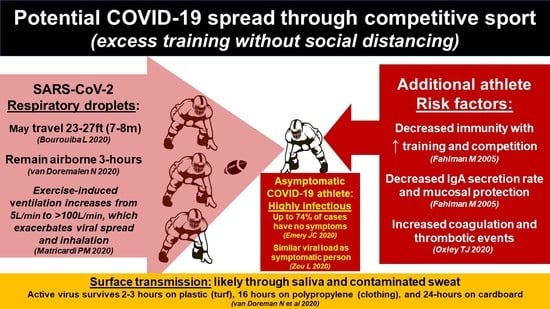Is Exercise the Best Medicine during a COVID-19 Pandemic? Comment on Constandt, B.; Thibaut, E.; De Bosscher, V.; Scheerder, J.; Ricour, M.; Willem, A. Exercising in Times of Lockdown: An Analysis of the Impact of COVID-19 on Levels and Patterns of Exercise among Adults in Belgium. Int. J. Environ. Res. Public Health 2020, 17, 4144
Abstract
:Author Contributions
Funding
Conflicts of Interest
References
- Constandt, B.; Thibaut, T.; De Bosscher, V.; Scheerder, J.; Ricour, M.; Willem, A. Exercising in Times of Lockdown: An Analysis of Impact of COVID-19 on Levels and Patterns of Exercise among Adults in Belgium. Int. J. Environ. Res. Public Health 2020, 17, 4144. [Google Scholar] [CrossRef] [PubMed]
- Goodenough, P. Of 10 Hardest-Hit Countries, US Has 2nd-Lowest Case-Fatality Rate, 4th-Lowest Per Capita Death Toll. CNSnews.com. 1 May 2020. Available online: https://www.cnsnews.com/article/international/patrick-goodenough/10-hardest-hit-countries-us-has-2nd-lowest-case-fatality (accessed on 7 August 2020).
- Lobelo, F.; Young, D.R.; Sallis, R.; Garber, M.D.; Billinger, S.A.; Duperly, J.; Hutber, A.; Pate, R.R.; Thomas, R.J.; Widlansky, M.E.; et al. Routine Assessment and Promotion of Physical Activity in Healthcare Settings: A Scientific Statement from the American Heart Association. Circulation 2018, 137, e495–e522. [Google Scholar] [CrossRef] [PubMed]
- Wong, C.-M.; Lai, H.-K.; Ou, C.-Q.; Ho, S.-Y.; Chan, K.-P.; Thach, T.-Q.; Yang, L.; Chau, Y.K.; Lam, T.H.; Hedley, A.J.; et al. Is Exercise Protective Against Influenza-Associated Mortality? PLoS ONE 2008, 3, e2108. [Google Scholar] [CrossRef] [PubMed] [Green Version]
- Jang, S.; Han, S.H.; Rhee, J.-Y. Coronavirus disease cluster associated with fitness dance classes, South Korea. Emerg. Infect. Dis. 2020, 26, 1917–1920. [Google Scholar] [CrossRef] [PubMed]
- Matricardi, P.M.; Dal Negro, R.W.; Nisini, R. The First, Holistic Immunological Model of COVID-19: Implications for Prevention, Diagnosis, and Public Health Measures. Pediatr. Allergy Immunol. 2020. [Google Scholar] [CrossRef] [PubMed]
- Emery, J.C.; Russell, T.W.; Liu, Y.; Hellewell, J.; Pearson, C.A.B.; CMMID 2019-nCoV Working Group; Knight, G.M.; Eggo, R.M.; Kucharski, A.J.; Funk, S.; et al. The Contribution of Asymptomatic Sars-Cov-2 Infections to Transmission—A Model-Based Analysis of the Diamond Princess Outbreak. CMMID Repository. Available online: https://cmmid.github.io/topics/covid19/asymp-transmission.html (accessed on 7 August 2020).
- Zou, L.; Luan, F.; Huang, M.; Hong, Z.; Yu, J.; Kang, M.; Yu, J.; Kang, M.; Song, Y.; Xia, J.; et al. SARS-CoV-2 Viral Load in Upper Respiratory Specimens of Infected Patients. N. Eng. J. Med. 2020, 382, 12. [Google Scholar] [CrossRef] [PubMed]
- Burton, D.A.; Stokes, K.; Hall, G.M. Physiological effects of exercise. Contin. Educ. Anaesth. Crit. Care Pain 2004, 4, 185–188. [Google Scholar] [CrossRef]
- van Doremalen, N.; Bushmaker, T.; Morris, T.H.; Holbrook, M.G.; Gamble, A.; Williamson, B.N.; Tamin, A.; Harcourt, J.; Thornburg, N.; Gerber, S.; et al. Aerosol and surface stability of HCoV-19 (SARS-CoV-6 2) compared to SARS-CoV-1. medRxiv 2020. [Google Scholar] [CrossRef] [Green Version]
- Bourouiba, L. Turbulent Gas Clouds and Respiratory Pathogen Emissions Potential Implications for Reducing Transmission of COVID. JAMA 2020, 323, 1837–1838. [Google Scholar]
- Anfinrud, P.; Bax, C.E.; Stadnytskyi, V.; Bax, A. Could SARS-CoV-2 be transmitted via speech droplets? medRxiv 2020. [Google Scholar] [CrossRef]
- To, K.K.-W.; Tsang, O.T.-Y.; Yip, C.C.; Chan, K.-H.; Wu, T.-C.; Chan, J.M.C.; Leung, W.S.; Chik, T.S.H.; Choi, C.Y.C.; Kandamby, D.H.; et al. Consistent Detection of 2019 Novel Coronavirus in Saliva. Clin. Infect. Dis. 2020, 71, 841–843. [Google Scholar] [CrossRef] [PubMed] [Green Version]
- Fahlman, M.M.; Engels, H.J. Mucosal IgA and URTI in American College Football Players: A Year Longitudinal Study. Med. Sci. Sports Exerc. 2005, 37, 374–380. [Google Scholar] [CrossRef] [PubMed]
- Korean Society of Infectious Diseases. Report on the Epidemiological Features of Coronavirus Disease 2019 (COVID-19) Outbreak in the Republic of Korea from January 19 to March 2. J. Korean Med. Sci. 2020, 35, e112. [Google Scholar] [CrossRef] [PubMed]
- Oxley, T.J.; Mocco, J.; Majidi, S.; Kellner, C.P.; Shoira, H.; Singh, I.P.; De Leacy, R.A.; Shigematsu, T.; Ladner, T.R.; Yaeger, K.A.; et al. Large-Vessel Stroke as a Presenting Feature of Covid-19 in the Young. N. Eng. J. Med. 2020, 382, e60. [Google Scholar] [CrossRef] [PubMed]
- DeLaFuente, H. More Universities Report Coronavirus Cases in Athletics Programs. CNN. Available online: https://www.cnn.com/2020/06/07/us/universities-athletic-programs-coronavirus/index.html (accessed on 8 June 2020).
© 2020 by the authors. Licensee MDPI, Basel, Switzerland. This article is an open access article distributed under the terms and conditions of the Creative Commons Attribution (CC BY) license (http://creativecommons.org/licenses/by/4.0/).
Share and Cite
Hew-Butler, T.; Smith-Hale, V.; Van Sumeren, M.; Sabourin, J.; Levy, P. Is Exercise the Best Medicine during a COVID-19 Pandemic? Comment on Constandt, B.; Thibaut, E.; De Bosscher, V.; Scheerder, J.; Ricour, M.; Willem, A. Exercising in Times of Lockdown: An Analysis of the Impact of COVID-19 on Levels and Patterns of Exercise among Adults in Belgium. Int. J. Environ. Res. Public Health 2020, 17, 4144. Int. J. Environ. Res. Public Health 2020, 17, 5730. https://0-doi-org.brum.beds.ac.uk/10.3390/ijerph17165730
Hew-Butler T, Smith-Hale V, Van Sumeren M, Sabourin J, Levy P. Is Exercise the Best Medicine during a COVID-19 Pandemic? Comment on Constandt, B.; Thibaut, E.; De Bosscher, V.; Scheerder, J.; Ricour, M.; Willem, A. Exercising in Times of Lockdown: An Analysis of the Impact of COVID-19 on Levels and Patterns of Exercise among Adults in Belgium. Int. J. Environ. Res. Public Health 2020, 17, 4144. International Journal of Environmental Research and Public Health. 2020; 17(16):5730. https://0-doi-org.brum.beds.ac.uk/10.3390/ijerph17165730
Chicago/Turabian StyleHew-Butler, Tamara, Valerie Smith-Hale, Matthew Van Sumeren, Jordan Sabourin, and Phillip Levy. 2020. "Is Exercise the Best Medicine during a COVID-19 Pandemic? Comment on Constandt, B.; Thibaut, E.; De Bosscher, V.; Scheerder, J.; Ricour, M.; Willem, A. Exercising in Times of Lockdown: An Analysis of the Impact of COVID-19 on Levels and Patterns of Exercise among Adults in Belgium. Int. J. Environ. Res. Public Health 2020, 17, 4144" International Journal of Environmental Research and Public Health 17, no. 16: 5730. https://0-doi-org.brum.beds.ac.uk/10.3390/ijerph17165730




